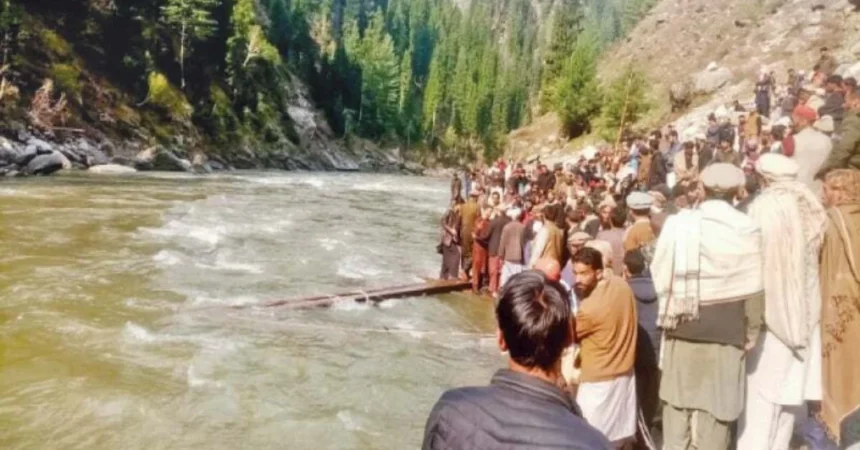Introduction
In a heartbreaking incident that underscores the risks associated with modern tourism, a tourist drowned in the Neelum River while attempting to take a selfie. This tragedy highlights the growing trend of selfie-related accidents, prompting a discussion about the need for increased awareness and safety measures for travelers. This article explores the circumstances surrounding the incident, the inherent dangers of selfie culture, and its broader implications for tourism in the region.
The Incident
The unfortunate event occurred when a group of tourists visited the picturesque Neelum Valley, renowned for its stunning landscapes and natural beauty. As many travelers do, one of the tourists sought to capture a memorable moment against the backdrop of the river, which is famed for its crystal-clear waters and breathtaking scenery. However, as the individual leaned over the edge to snap the perfect photo, a sudden wave or misstep led to a tragic fall into the river.
Eyewitnesses reported that the tourist struggled to stay afloat as the strong current of the river swept them away. Despite immediate efforts from fellow tourists and locals to rescue the individual, the swift water and rocky terrain made the situation perilous. Emergency services were called to the scene, but unfortunately, their efforts came too late, and the tourist was pronounced dead after being recovered from the river.
The Dangers of Selfie Culture
The allure of capturing the perfect selfie has led to a rise in accidents and fatalities around the world. In recent years, there have been numerous reports of individuals losing their lives while attempting to take selfies in dangerous locations, such as cliffs, waterfalls, and, as seen in this case, rivers. The phenomenon raises critical questions about risk awareness and the responsibility of both tourists and local authorities.
1. The Psychology Behind Selfies:
The desire to document personal experiences and share them on social media platforms drives many to take selfies in risky environments. The need for validation and attention often outweighs the consideration of potential dangers. This mindset can lead individuals to take unnecessary risks for the sake of a “like” or a comment, often ignoring the potential consequences.
2. Lack of Awareness:
Many tourists may not be aware of the inherent dangers associated with specific locations. Natural bodies of water like the Neelum River can be particularly treacherous, with strong currents and unpredictable conditions. Tourists often underestimate the power of nature, leading to dangerous situations.
3. Inadequate Safety Measures:
While many tourist destinations implement safety measures, such as warning signs and barriers, enforcement can be lacking. In some cases, local authorities may not have the resources to adequately inform or protect tourists from risky behaviors. This incident highlights the need for improved safety protocols and awareness campaigns in popular tourist areas.
The Implications for Tourism
This tragic incident serves as a wake-up call for the tourism industry, emphasizing the need for greater responsibility and awareness among travelers. The repercussions of such events extend beyond the immediate loss of life; they also impact the local community and tourism sector.
1. Impact on Local Communities:
Tourist-related accidents can strain local resources and emergency services. In the aftermath of a drowning, communities may face increased scrutiny and pressure to improve safety measures. Additionally, the emotional toll on local residents who witness such tragedies can be profound.
2. Perception of Safety:
Incidents like this can significantly impact how potential tourists perceive a destination. Safety concerns may deter travelers from visiting areas known for accidents, ultimately affecting the local economy that relies heavily on tourism. It is essential for local authorities and tourism boards to proactively address safety issues to maintain the region’s appeal.
3. Need for Education and Awareness:
The tourism industry must take a proactive stance in educating visitors about safety. Informative campaigns that highlight potential risks and promote safe practices can go a long way in preventing future accidents. Collaboration between local authorities, tourism operators, and community organizations is crucial to fostering a culture of safety among tourists.
The Role of Local Authorities
In light of this tragic incident, local authorities play a crucial role in ensuring the safety of tourists. They must implement strategies that prioritize visitor safety while promoting the beauty of the region.
1. Improved Infrastructure:
Enhancing infrastructure around popular tourist spots can help reduce accidents. This includes building barriers near water bodies, installing clear signage about potential dangers, and creating safe viewing areas for photographs. These measures can help mitigate risks associated with selfie-taking.
2. Regular Safety Audits:
Conducting regular safety audits at tourist locations can help identify potential hazards. Local authorities should work with tourism experts to evaluate areas that may pose risks to visitors and take corrective actions promptly.
3. Emergency Response Plans:
Developing and communicating emergency response plans is essential for tourist safety. This includes ensuring that local emergency services are adequately trained and equipped to respond to incidents swiftly. In addition, promoting awareness among tourists about what to do in case of an emergency can save lives.
4. Collaboration with Tourism Operators:
Local authorities should collaborate with tour operators to create a unified approach to safety. By providing training and resources, operators can educate their clients about safe practices and the importance of respecting nature while exploring.
Recommendations for Safer Tourism Practices
To mitigate the risks associated with selfie culture and promote safer tourism practices, several recommendations can be implemented:
1. Awareness Campaigns:
Local tourism boards should launch awareness campaigns that educate tourists about the dangers of taking selfies in risky areas. These campaigns can utilize social media, brochures, and signs at popular tourist spots to convey the message effectively.
2. Safety Signage and Barriers:
Installing clear signage that warns of the dangers associated with specific locations can help deter risky behavior. Additionally, physical barriers can be put in place to prevent tourists from venturing too close to hazardous areas, especially near bodies of water.
3. Training for Tour Guides:
Tour operators should ensure that guides are trained to identify risky situations and educate tourists about safe practices. Guides can play a vital role in promoting safety and ensuring that tourists are aware of their surroundings.
4. Emergency Response Training:
Local communities should invest in training programs for emergency responders to equip them with the skills needed to handle tourist-related incidents effectively. Prompt and efficient emergency response can save lives in critical situations.
5. Promote Responsible Tourism:
Encouraging responsible tourism practices can foster a culture of safety among travelers. Tourists should be reminded of the importance of respecting nature and understanding their limitations when exploring new environments.
The Broader Cultural Context
The incident of the tourist drowning in the Neelum River also brings to light broader cultural and social issues surrounding tourism and technology. The pervasive nature of social media and the obsession with documenting experiences have led to a culture where risks are often ignored for the sake of a perfect image.
1. Social Media Influence:
Platforms like Instagram and TikTok play a significant role in shaping travel behavior. Many individuals feel pressured to capture extraordinary moments that often lead them to perilous situations. The desire to impress followers can overshadow the need for safety.
2. Education and Cultural Shift:
There is a need for a cultural shift in how we approach tourism and social media. Education campaigns should emphasize the importance of safety over spectacle. Influencers and travel bloggers can play a pivotal role in setting examples of responsible behavior while exploring new destinations.
The drowning of a tourist in the Neelum River while taking a selfie is a tragic reminder of the risks associated with modern tourism and the selfie culture that has permeated social media. As the tourism industry continues to grow, it is imperative for local authorities, tourism operators, and travelers themselves to prioritize safety and awareness. By implementing preventive measures and fostering a culture of responsible tourism, we can help prevent similar incidents in the future and ensure that the beauty of destinations like Neelum Valley can be enjoyed safely by generations to come.
#TourismSafety #SelfieCulture #NeelumRiver #TravelAwareness #ResponsibleTourism







